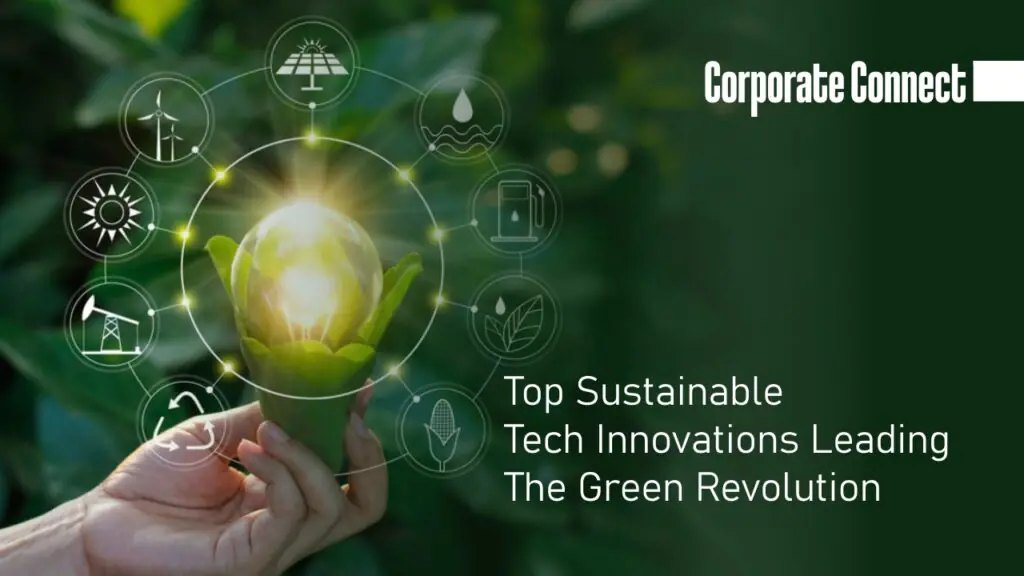By Jaya Pathak
Technology is evolving at an astonishing speed. Politicians as well as environmentalists are delighted emphasizing on green technology innovations. With the advancement in technology. Green technology innovations aim to create a sustainable future for the planet. Green solution is not simply a trend but a necessity as it addresses the issue of consequences of climate change and the urgent requirement to reduce our environmental footprint.
Top sustainable tech innovations leading the green revolution in 2025
What is Green Technology?
Green technology is the development and use of technology to understand and address issues which affects environment with the aim of fostering environmental improvement. It applies the knowledge of science and technology and the process of addressing environmental challenges through Environmental Conservation and the mitigation of human impact to the environment.
It Involves purification and waste management including water purification, air purification sewage treatment, environmental damage radiation, waste management, e-waste recycling, bioremediation, the renewable energy, energy conservation and many more.
Some sustainable tech innovations leading the green revolution
1. Renewable energy technologies
Renewable energy technologies are those technologies which can be used to produce energy from direct and indirect effects on the earth from the sun’s energy. It has become an increasingly favourable alternative to conventional energy sources to assuage these few fossils fuel related issues. It has the potential to harness natural processes to generate energy from renewable sources such as sunlight, wind, water and biomass. Shifting towards renewable energy resources will help us to reduce our dependence on finite resources and support a clean and resilient power system
2. Circular economy practices
Circular economy refers to a model of resource production and consumption in any economy that involves sharing former reusing, repairing refurbishing and recycling existing materials and products for as long as possible. The concept aims to tackle global challenges such as climate changes, biodiversity loss, waste and pollution by emphasizing the design-based implementation of the three basic principles of the model. The three principles required for the transformation to a circular economy are – Designing out waste and pollution, keeping products and materials in use and regenerating natural systems.
3. Vertical farming
Vertical farming is the practice of growing crops in vertically and horizontally stacked layers. It is a method of growing crops in vertically stacked layers using hydroponics aeroponics and optimized LED lighting often without any soil. This technology will reduce the need for land and water compared to traditional farming as plants can be given precise nutrition and water can be recirculated. Since, vertical farming comprises controlled conditions therefore it removes the need for pesticides. Some common choices of structures to house vertical farming systems include shipping containers, buildings, underground tunnels and abandoned mineshafts.
4. Blockchain
It is a decentralised digital record book which records transactions across multiple computers, ensuring data integrity and transparency. It can be used for supply chain transparency by providing a tamper- proof record of each step in the supply chain. Companies and consumers can verify ethical practices, product origins and sustainability credentials. Concordium uses this technology to enhance the credibility of ESG through a trusted, secure and transparent platform.
5. Water purification technologies
Water purification is the process of removing undesirable chemicals, biological contaminants, suspended solids and gases from water. The goal is to produce water that is fit for specific purposes. The water purification technology will help to remove the contaminants from water by making it suitable for drinking purposes.
As per the reports of World Health Organization, around 2 billion people do not have access to safe drinking water which is equals to one in three people globally. There are technologies such as reverse osmosis and UV filtration which will provide access to safe and clean water. The World Health Organization have estimated that around 1,000,000 people die from waterborne diseases each year. Therefore there is an urgency to provide fresh water and provide innovative solutions.
6. Biodegradable packaging
It is any packaging that will naturally break down from microorganisms such as bacteria, fungus and algae, within a short period following disposal, usually a year or less. there are various types of biodegradable packaging materials including cornstarch, mushroom, seaweed, cellulose add paper.
Investing in biodegradable packaging can significantly save operational costs by utilizing fewer resources, reusing inventory and buying cost effective recycled materials. These materials are non-toxic and allergy free as compared to conventional packaging supplies. Eco friendly packaging enhances the brand’s image and it will demonstrate your concern for environment and corporate social responsibility. Additionally, it will reduce carbon dioxide emissions daily operations.
7. OK grids and energy management systems
Smart grid is the overlaying of unified communications and control system on the existing power delivery infrastructure to provide the right information to the right entity. It is an integration of technologies for the customer and the grid. Such technologies combine software and hardware including creations and essential services from generation to transmission and distribution.
An energy management system is basically an operator which revitalizes the execution and performance of the system and supervisory control and data acquisition. It is implemented in many industrial and commercial sectors. Smart grids and energy management systems optimize electricity distribution and corruption using data. Smart grids use digital technology in order to monitor and manage energy flows. This data is used to improve the efficiency and reliability.
8. Carbon capture and utilisation
Carbon capture and utilization technologies comprises of capturing carbon dioxide emissions before it enters into the atmosphere and causes any harm to the environment. The carbon dioxide which is captured can be Convert it into useful products. This technology will help in reducing the emissions of greenhouse gas and ultimately it will support the development of a circular carbon economy. It will emerge as a key technology to achieve the Paris agreement climate goals.
9. Green building materials
The green building which is also known as green construction, refers to the structure and the application of processes that are environmentally responsible and resource efficient throughout a building’s life cycle right from planning to designing, construction, operation, maintenance, renovation and demolition. It requires close cooperation of the contractor, architects, engineers and the client at all project ages.
This practice expands and complements the classic building design concerns of economy, utility, durability and comfort. It refers to saving resources to the maximum extent including energy saving, lamb saving, water saving, material saving etc during the whole life cycle of the building, protecting the environment and reducing pollution, providing people with healthy, comfortable and efficient use of space and being in harmony with nature. Green building technology focuses on low consumption, high efficiency, economy, environmental protection, integration and optimization.
10. Precision agriculture
It is a management strategy that gathers, processes and analyzes temporal, spatial and individual plant and animal data and combines it with other information To support management decisions according to estimated variability for improved resource use efficiency, productivity, quality, profitability and sustainability of agricultural production. It is used in both crop and livestock production. It employs technologies to automate agricultural operations, improving their diagnosis, decision making or performing.
The goal of precision agriculture research is to define a decision support system for whole farm management with the goal of optimizing returns on inputs while preserving resources. precision agriculture Is the application of precise and correct amount of inputs like water, fertilizer, pesticides at the correct time to the crop for increasing its productivity and maximizing its yields. Precision agriculture management practices can reduce the amount of nutrients and crop inputs used and at the same time it will boost the yields.
Must Read:










